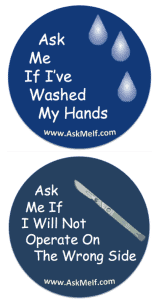I've been writing for a long time that I think it's inappropriate and ineffective to ask patients and families to inspect or police hand hygiene in hospital settings. It's the job of healthcare leaders to create systems that include enough time for nurses, doctors, and others to properly practice hand hygiene in the name of protecting patients.
Hanging more posters and cuter signs doesn't work… lack of hygiene is not an education or awareness issue – it's a systems, processes, and leadership issue.
For years, I've gently mocked the “ask me if I've washed my hands” buttons that some staff are asked (or forced) to wear. I've pointed out that no other industry puts this quality inspection burden on their customers.
So, I've created a website, www.AskMeIf.com with parody buttons that seem silly in other situations… so hopefully the “ask me if I've washed my hands” buttons will seem silly, as well – and we can try things that might work. Read more about the new site here. And see the other buttons, including “Ask Me If I Will Not Operate on the Wrong Side.” See the other buttons here.
Proceeds from the sales of any buttons will be donated to the Louise Batz Patient Safety Foundation, where I am a board member.
Please scroll down (or click) to post a comment. Connect with me on LinkedIn.
Let’s build a culture of continuous improvement and psychological safety—together. If you're a leader aiming for lasting change (not just more projects), I help organizations:
- Engage people at all levels in sustainable improvement
- Shift from fear of mistakes to learning from them
- Apply Lean thinking in practical, people-centered ways
Interested in coaching or a keynote talk? Let’s talk.
Join me for a Lean Healthcare Accelerator Trip to Japan! Learn More











I’m not sure I necessarily agree that those buttons in particular are such a bad idea. If you consider for a moment that they are perhaps not intended for the customer at all, rather that they are to make the wearer feel more aware that the customer is always watching, then that can only help encourage the culture you want.
These buttons have been in use (and sold by The Joint Commission) for many years. If anybody can produce evidence that wearing these buttons:
1) increases hand hygiene compliance rates
2) reduces infections or improves patient outcomes
I love this (5 minute) video showing the effectiveness of relying on the usual suspect countermeasures to the hand hygiene problem:
http://youtu.be/o-N57TtyToE
A good demonstration of the need for multi-pronged approaches. Signs, education, and risk awareness are not sufficient.
After writing work instructions for years I probably scrutinize verbiage and signage more than necessary. When I see 1% milk on the shelf my thought is always “does anyone ask what the other 99 percent is?” In public restrooms “Employees required to wash their hands” I wish it would read “Everyone required to wash hands”. I also noticed more high schools designed with sinks in full view of hallway. Is this so students are shamed into washing hands? Makes you go hmmmm….
From a discussion on linkedin:
Seems one sided to say this puts the “burden” on patients? Does it not also prompt patients to ask questions? I do a lot of work in Healthcare and a number one complaint of patients / residents / clients is they do not understand their care. (The first principle of Lean is understanding the voice of the customer) When patients are additionally asked if they feel comfortable asking a care giver about their care the answer is quite commonly “no”. We just finished a survey at a major Canadian hospital and 87% of people did not understand their care and 84% did not want to ask questions. This button to me represents an open door to “talk to me about your care.”
My response:
His reply:
I still believe you are over simplifying the situation. The problem with a lot of healthcare measurement is we tend to measure the wrong thing. The “speaking up” is not what the buttons are measuring. If you want to know if the buttons are working then measure hospital acquired infections after implementation of the buttons, did it change staffs behaviour? Its like measuring compliance to surgical check list completion as a measure of patient safety? There may be a relationship but the true measure is reduction of surgical site infections, incorrect surgeries etc. not compliance to complete a check list. And I have a lot of data to support this.
My response:
Here’s a column that makes the same point about airlines not asking passengers to double check things:
Hospital safety:-‚Your responsibility or theirs?
Comments are closed.